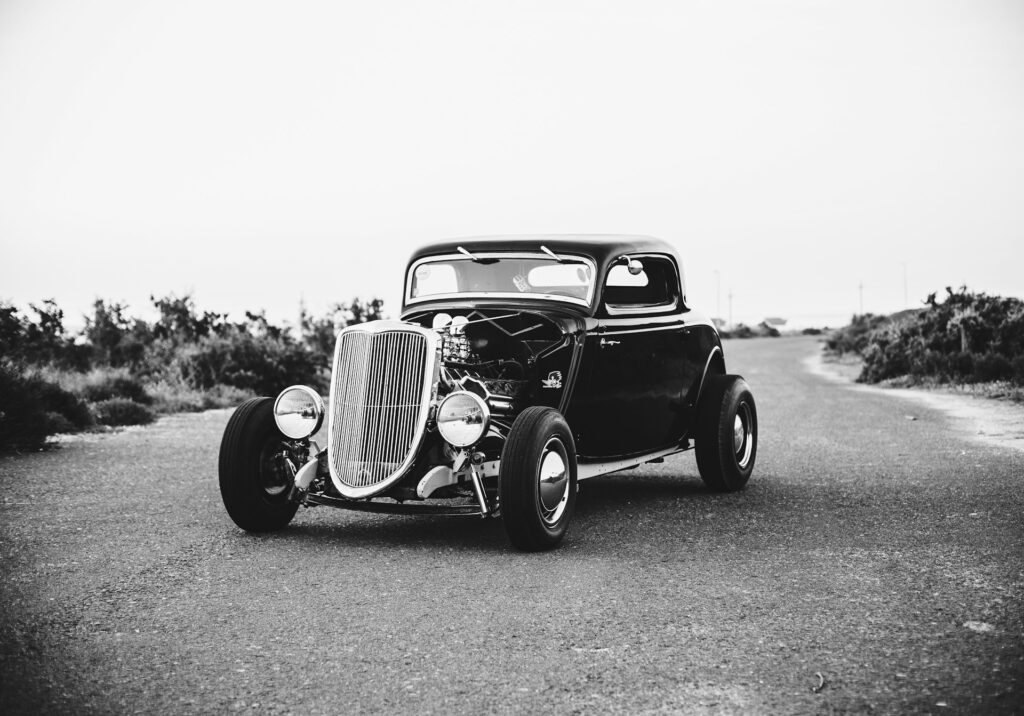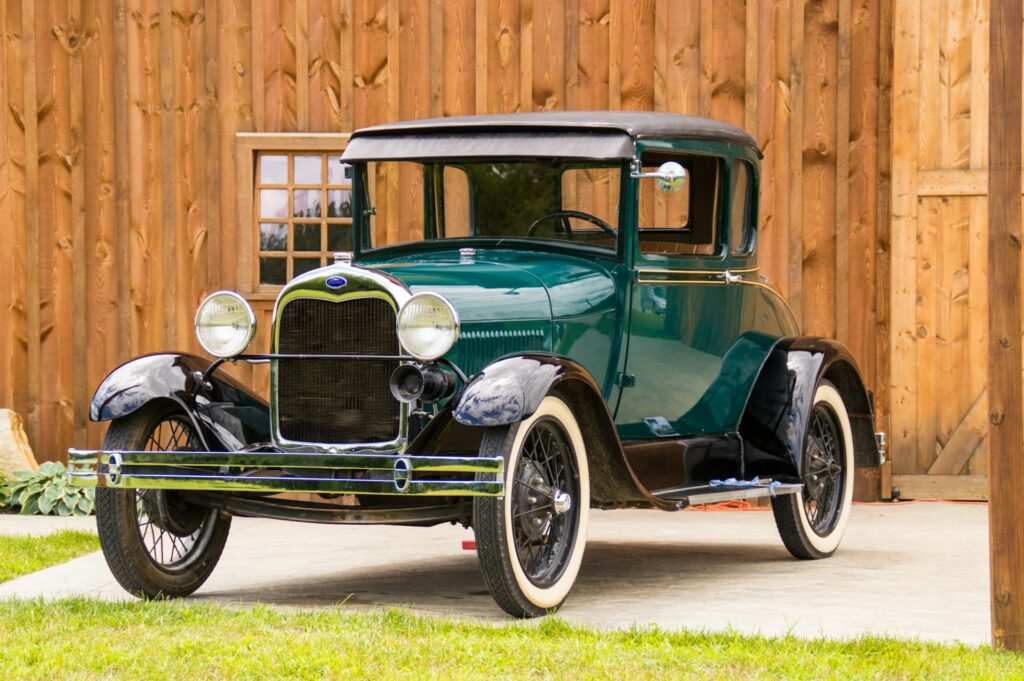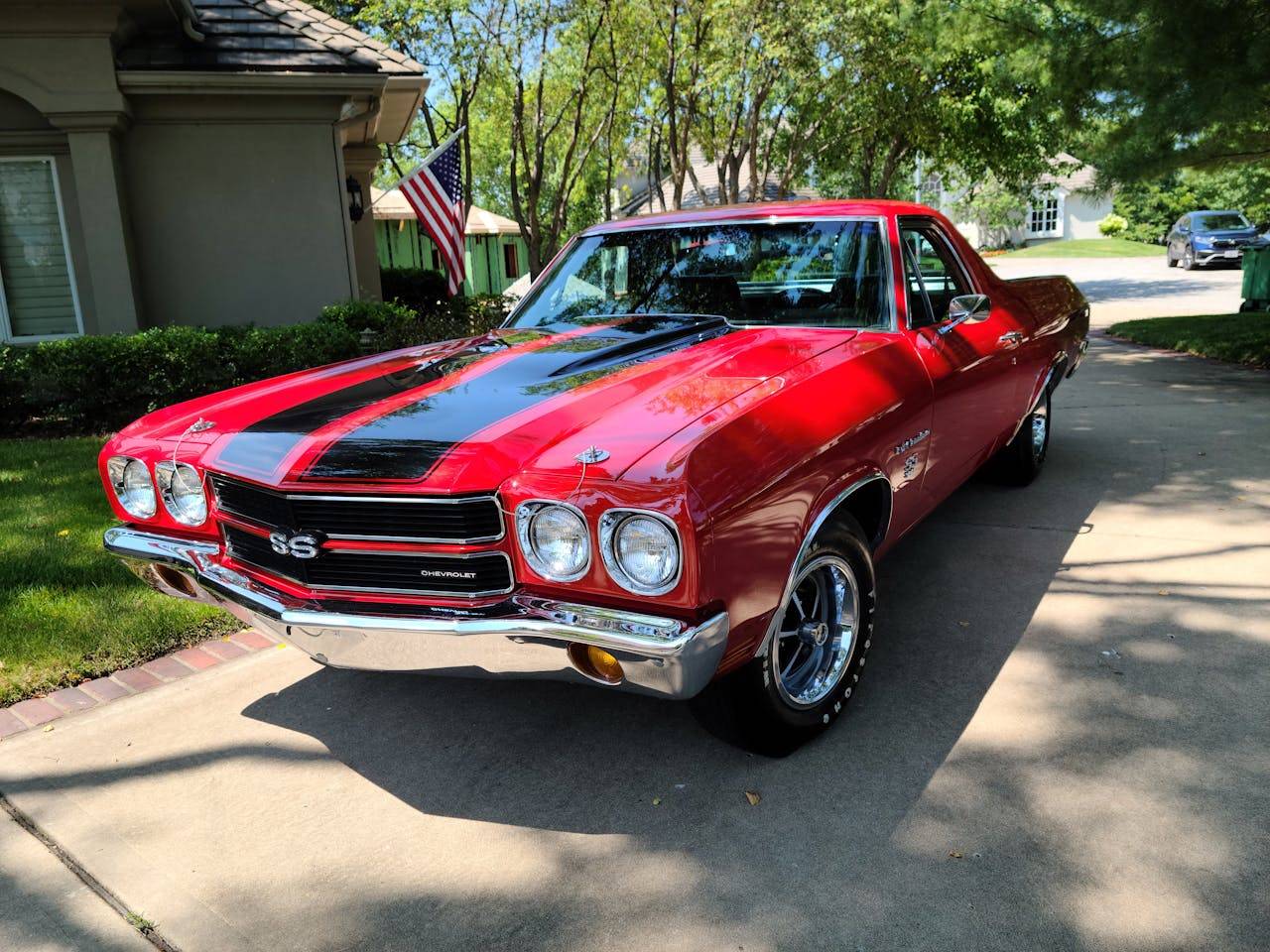When someone mentions classic American cars, Ford is likely the first company that comes to mind. For over a century since its launch in 1903, the Ford Motor Company has produced some of the most exciting and enduring models in the history of the automobile.
From pioneering the assembly line to inventing the quintessential muscle car to making the first affordable automobile for the masses, Ford is known for forever impacting the world of mobility.
First, we will dive deeper into the most popular vintage Ford models and explore their key features and distinctive characteristics. Then, we will explore the history behind their popularity and lasting appeal.
Ford Model T (1908-1927)

One car that changed the world: is the Ford Model T. It was introduced in 1908 and is nicknamed the ‘Tin Lizzie’. The ‘T’ was introduced in 1908. Produced by Henry Ford and the first car made on an assembly line, this first mass-produced car allowed you to get your little family car at a bargain price.
Powered by a 2.9-litre four-cylinder engine capable of delivering 20 horsepower and achieving a top speed of around 45 mph (compared with the barely 10 mph of some horse-drawn vehicles), the Model T embodied simplicity and robustness.
Not to mention affordability: by the time Ford ceased producing his ubiquitous small car in 1927, the company had sold more than 15 million. Its impact upon society was greater still: the Model T ingrained the image of freedom and mobility into the national psyche of the average American.
Ford Model A (1927-1931)

After the Model T, Ford released the Model A in 1927. This car was much better looking and had numerous new features. The Model A was manufactured in several lines, including sedans, coupes, and roadsters, thus appealing to the masses with dissimilar tastes.
Under the hood, the Model A came with a 3.3-litre inline-four that generated 40 horses. Four gears replaced its earlier three-speed transmission, and better-designed brakes and suspension systems improved reliability for the driver.
More than 4 million Model As rolled out of Ford’s factories during its production run, and it achieved its entry into the Ford Hall of Fame as another classic.
Ford V8 (1932-1934)
Then came the Ford V8 in 1932. It was the first car in the low-priced market to feature a V8 engine; it gave Henry Ford ‘the awesome power of eight cylinders’ at a price attainable to most people. Henry II – Henry’s only child – became president in 1945, and the first car with an overhead valve V8, the Mercury Monterey, powered by a 3.9-liter engine developed by the ORV Company, arrived on the market in 1953.
The advent of the potent V8 engines with their high compression (up to 10:1) came with a new cheap source of fuel in the 1950s: lead. In the first few decades, the car started simply as a device for taking a person from one place to another.
The early cars were not meant to change the world. They were simple machines designed to propel their inventors, often at great speed, across their neighborhood, but otherwise to do nothing more than what a fast horse could do.
The V8, prized by hot rodders and custom car guys the world over for being a low-cost, high-power engine and car to modify, and with sleek lines and aggressive stance that made it one of the most desirable cars of its kind of the immediate postwar period.
Mercury Eight (1939-1951)
Introduced in 1939, the Mercury Eight was the first model from Ford to break into the mid-priced automotive category; positioned between the Ford and Lincoln nameplates, the Mercury line offered greater luxury and performance than the base Ford models at a significantly lower price than a Lincoln car.
The early Mercury Eights offered a 3.9-litre (95bhp) V8 as the standard engine, which offered an unbridled fun-to-drive experience.
Its sleek styling, hydraulic brakes, and independent front suspension offered performance that would be difficult to match while retaining a claim to luxury.
These attributes let the Mercury Eight become among the most respected US midprice cars of the time, not to mention one of the best-selling. Indeed, the Mercury Eight’s reliability and comfort created a strong future for Mercury.
Ford F-Series (1948-Present)
The Ford F-Series, launched in 1948, is one of the most enduring and popular vehicle lines in automotive history. Available in every size, from compact pickups to giant rigs with industrial-scale towing capacity, the F-Series traces its roots to the no-nonsense workhorse pickup truck but has evolved into a heavily accessorized, customizable utility vehicle with uses and buyers as varied as the US population itself.
While the trucks, exemplified by the early F-1, had flathead V8 engines, solid front axles attached to the frame, and little or no creature comforts, they were built to last.
With continued innovation through the decades to the production of the current model year, the F-Series has evolved to meet changing market needs, including the incorporation of the latest technology and engineering know-how, advanced safety features, and powerful, fuel-efficient engines.
The F-Series saga exemplifies how new technologies are leading to new drivers.
Ford Thunderbird (1955-1997, 2002-2005)
But by far the purest expression of this idea, and the most important personal luxury vehicle of them all, is the Ford Thunderbird that debuted in 1955. It was the original personal luxury model, a sporty coupe with a top-end six-cylinder engine.
Advertising boasted that the Thunderbird was ‘not a sports car and not a conventional luxury car’ but ‘somewhere in between.’ It had been developed to compete with the Chevrolet Corvette, as much a sports car as any Porsche would have been.
Still, along the way, Ford saw the potential for another, more spacious and luxurious rival to the Cadillac’s tail-finned limos. Cadillacs were the epitome of US luxury, extravagant modes of conveyance for chauffeured clients.
But the new Thunderbird was a different kind of treasure chest for one person only. As a review in The New York Times put it soon after its release: ‘The Thunderbird affords the delights and prestige of motoring luxury without sacrificing the speed and sense of performance that contribute to sports appeal.’
When it first hit the market, the original Thunderbird had a 4.8-litre V8 that built 193 horsepower. It became known for its stylish design, comfortable interior, and smooth ride.
The design changed with each generation, and its size and performance evolved dramatically five times during its lengthy history of nearly 50 years, becoming an icon of car design and culture in the US.
Ford Mustang (1964-Present)
Any discussion of cars produced by Ford Motor Company during the vintage era would be complete with some mention of the Ford Mustang. This vehicle – launched in 1964 – created a new form of automobile, the so-called ‘pony car,’ which combines sporty styling and proportions with compactness and affordability.
The first-generation Mustang was a massive hit, with sales reaching more than one million units in the first two years. It included a modest 2.8-litre inline-six, a proper 4.7-litre V8, and a selection of optional features, paint jobs, and trim levels.
Some decades have seen greater change, while others reveled in the original legacy. Examples include the Shelby GT350 and GT500 high-performance variants as well as the fuel-efficient Mustang II produced during the energy crisis. Even today, the Mustang Carrillo maintains its tracks within the global automotive landscape.
Lincoln Continental (1939-Present)
The Lincoln Continental, announced in the autumn of 1939, is Ford’s prestige large luxury car. Long-reputed for its style, comfort, and cutting-edge features, the Continental has been a touchstone of US luxury ever since. Revello’s lead Continental features a 4.8-litre V12, one of the smoothest and most powerful engines of the period.
As time went on, and with every new version of the Continental, this car was transformed, using the day’s technology to put a mighty engine under the hood and top-drawer luxury on the inside. The first-generation Continentals sported dramatic ‘suicide doors,’ and the later models were at the cutting edge of automotive technology and American luxury.
Ford Bronco (1966-1996, 2021-Present)
Introduced by Ford in 1966, this rugged four-wheel-drive vehicle was one of the original sport utility vehicles (‘SUVs’) produced; it could be driven on the road or off, and it quickly became popular among outdoors enthusiasts and families alike.
Ford imbued it with body-on-frame construction, four-wheel drive, and a series of powerful engines that gave the first-generation Bronco both capability and versatility.
After a decade-long absence, the Bronco returned in 2021 with all-terrain technology and off-roading capabilities, wrapped in a retro shell reminiscent of the original models. This new Bronco has revived the nameplate as a hot commodity for vintage car lovers and a new generation of motorists.
Ford GT (2005-2006, 2016-Present)
The Ford GT is a modern supercar inspired by the iconic Ford GT40 of the 1960s, which dominated the Le Mans races. It was introduced in 2005 as a limited-production run to celebrate Ford’s 100th anniversary and its racing heritage.
Its 5.4-liter supercharged V8, developing 550 horsepower, matches a rakish, slippery, advanced-looking body that looks modern. However, it bears a family resemblance to similar GT prototypes produced by Ford and tested at Le Mans in the early 1960s.
When Ford announced a new-generation GT in 2016, equipped with a 3.5-litre twin-turbo V6 developing more than 600 horsepower, the new car looked similarly advanced.
Final Thoughts
The company that he founded – Ford Motor Company – continues to evoke all these aspects of innovation, performance, and affordability through every vintage model of its vehicles; vintage Fords demand record prices at auction and spark the imagination of petrolheads everywhere they are featured, as they did when Australian race driver and TV host Jamie Whincup sprayed a vector-suited Matt Damon with champagne after Whincup won this year’s Bathurst 1000 with a car reminiscent of the Mustang that Ford produced for the first time in 1964.








Leave a Comment